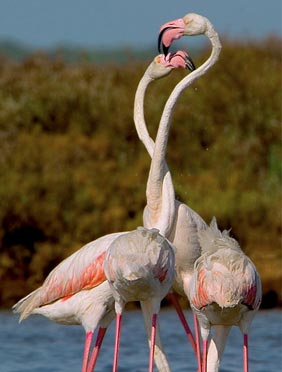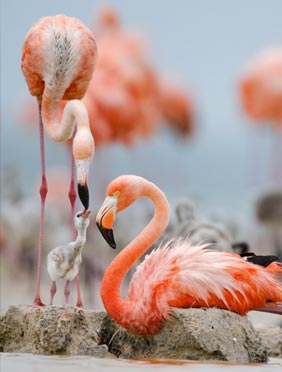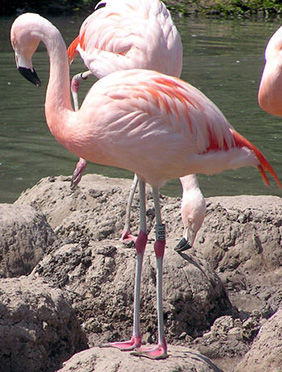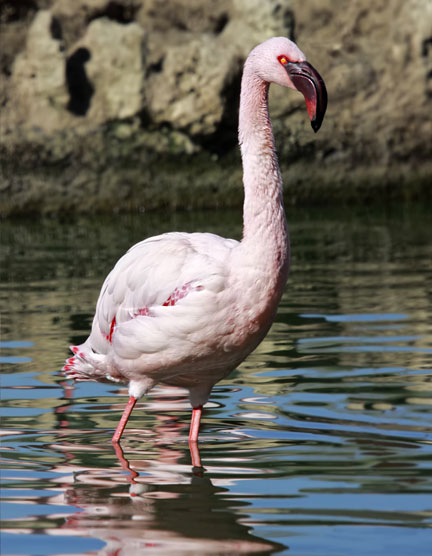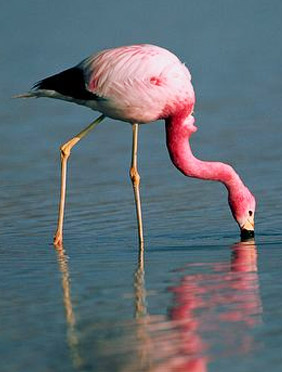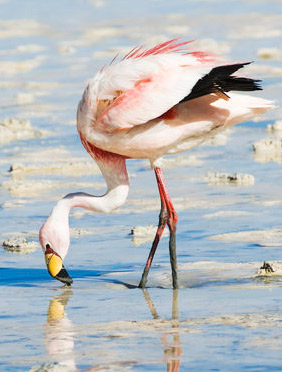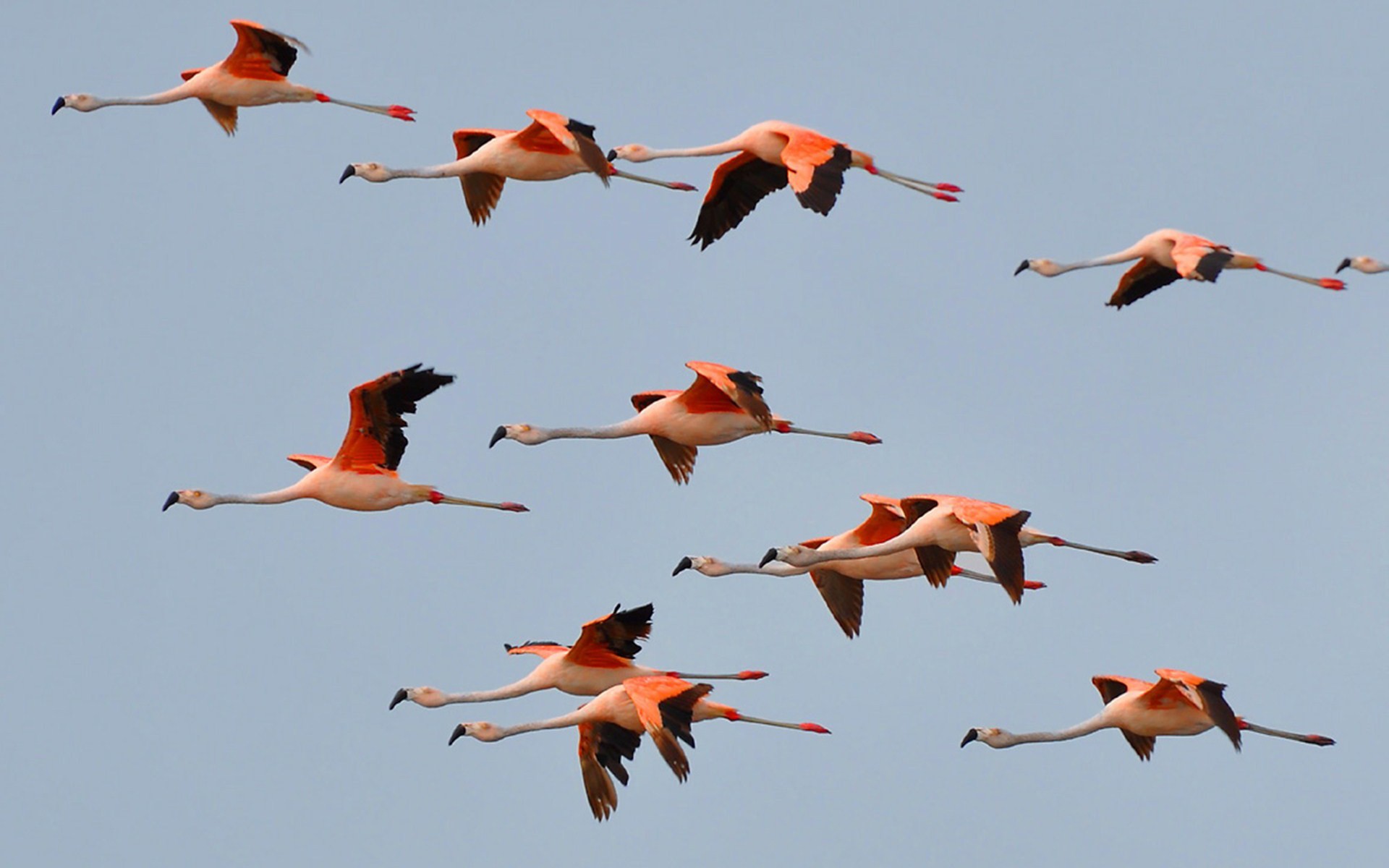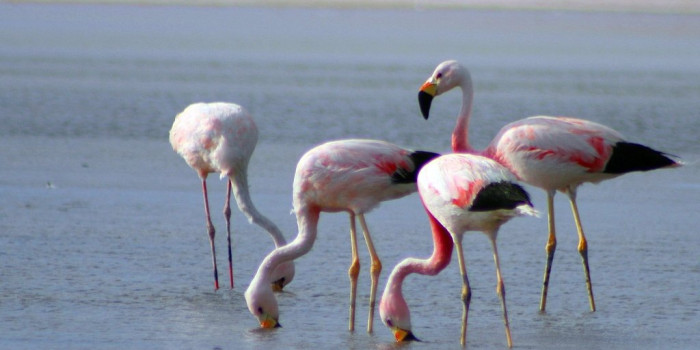"The classification of flamingos has baffled taxonomists for years"
flamingos
BASIC ASPECTS.
Tflamingos are long-legged, mostly pink birds. These waterfowl live in the wild in Africa, Asia, Europe, insular America, and South America. The number of species is still under debate. Most authorities recognize six species, all belonging to the family Phoenicopteridae. Some sources consider the Greater Flamingo and the Caribbean Flamingo separate species.
The largest species is the Greater Flamingo reaching 1.2 to 1.5 m (3 ft 11 in to 4 ft 11 in) in height and weighing up to 3.5 kg (7.7 lb). The smallest species is the Lesser Flamingo, standing 80 cm (2 ft 7.5 in) tall and weighing 2.5 kg (5.5 lb). Both species are found in the Old World, while the Caribbean Flamingo, Andean Flamingo, Chilean Flamingo, and James's Flamingo are found in the New World.
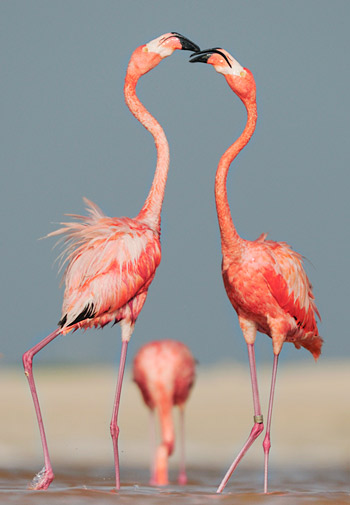
CLASSIFICATION.
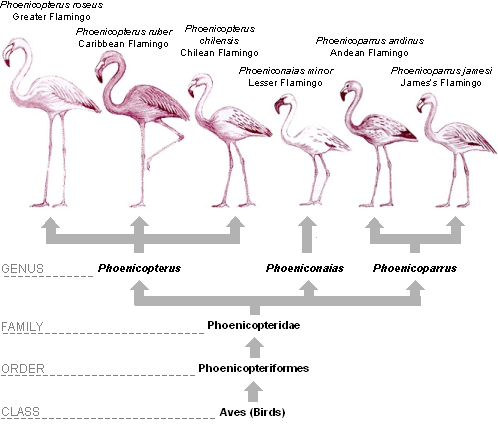
Flamingos share characteristics in common with a number of groups of birds, and it is not clear to which group they are most closely related. They are normally placed in the Order Ciconiiformes, but recent trends have become increasingly accepted.
Everything points to the flamingos being placed in their own separate group, The Phoenicopteriformes.
Ciconiiformes (storks, herons and ibis)
Anseriformes (ducks, geese and swans)
Charadriiformes (waders or shorebirds and their allies)
Podicipediforms (greons)
«Pink Flamingo or Greater Flamingo»
Pink flamingo,
(Phoenicopterus roseus).
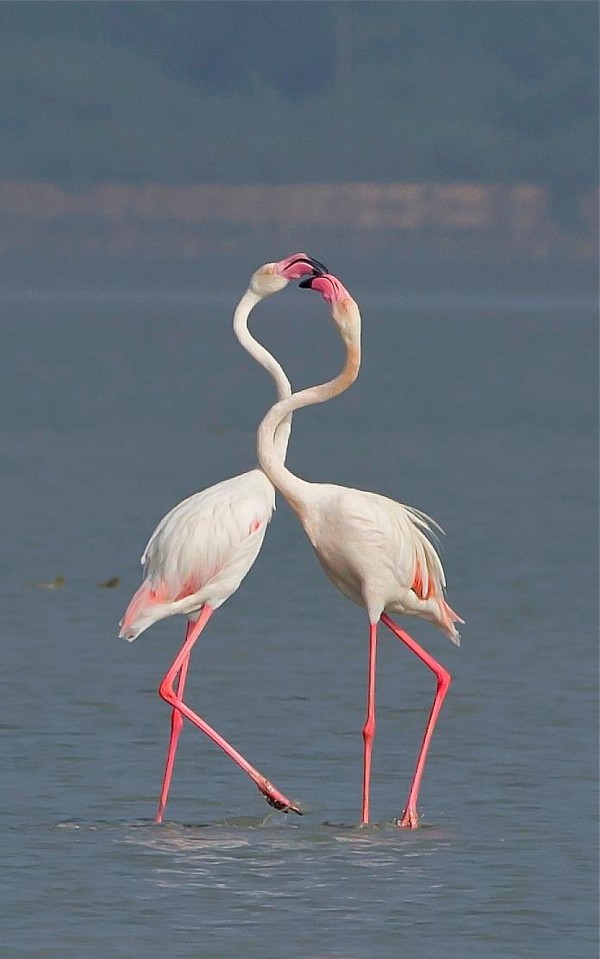
Ts the largest, palest, and most widespread of all the flamingo species. It is found in parts of Africa, Southwest Asia, South Asia, and southern Europe. It shares the genus Phoenicopterus with both the Caribbean flamingo and the Chilean flamingo, but is more closely related to the Caribbean flamingo. There is still debate as to whether these two types of flamingo are actually separate species or simply sub-species of Phoenicopterus ruber.
When considered a sub-species the scientific name for the flamingo is Phoenicopterus ruber roseus. It is distinguished from all other flamingos by its large size (averaging 110 to 150 cm) together with its pale plumage.
General:
"Caribbean Flamingo"
Caribbean Flamingo,
(Phoenicopterus ruber).

The Caribbean Flamingo (Phoenicopterus ruber) is the most intensely pink of all flamingos and the only species that does not share any part of its range with other flamingo species.
Also known as American flamingo - it can be found on all the coasts of the Caribbean islands, and in some continental countries such as Mexico, Venezuela and Colombia, being able to observe flocks feeding from Florida (USA) even reaching Honduras (Anuar Romero 2022) and northern Brazil, occasionally (Murillo-Pacheco et al 2013; Bernardon B. 2014).
They have an insular and a continental distribution. It uses the surroundings of all the islands of both the Greater Antilles and the Lesser Antilles to feed, with specimens being observed from Florida, United States, to the north of Brazil and a continental distribution, in several countries with Caribbean coasts, such as Mexico, Colombia. Venezuela and occasionally Honduras and Brazil. There is a population in Ecuador, in the Pacific Ocean, (Galapagos) but it is genetically isolated from those in the Caribbean (Frías Soler 2014). However, it is important to know that all the individuals that are observed throughout its wide range of distribution are born only from five colonies of
reproduction that are those that currently exist in countries such as: Bahamas, Cuba, Venezuela, Bonaire and Mexico (Gálvez et al 2015; 2021). In the Dominican Republic a very small colony of nests was reported (Paulino MM, Mejía DA, Latta SC. 2010) but has not been subsequently confirmed.
It is distinguished from all other flamingos by its large size (almost as large as the great flamingo, averaging up to 140 cm) in combination with its brilliant orange-pink plumage.
General:
"Chilean Flamingo"
Chilean Flamingo,
(Phoenicopterus chilensis).
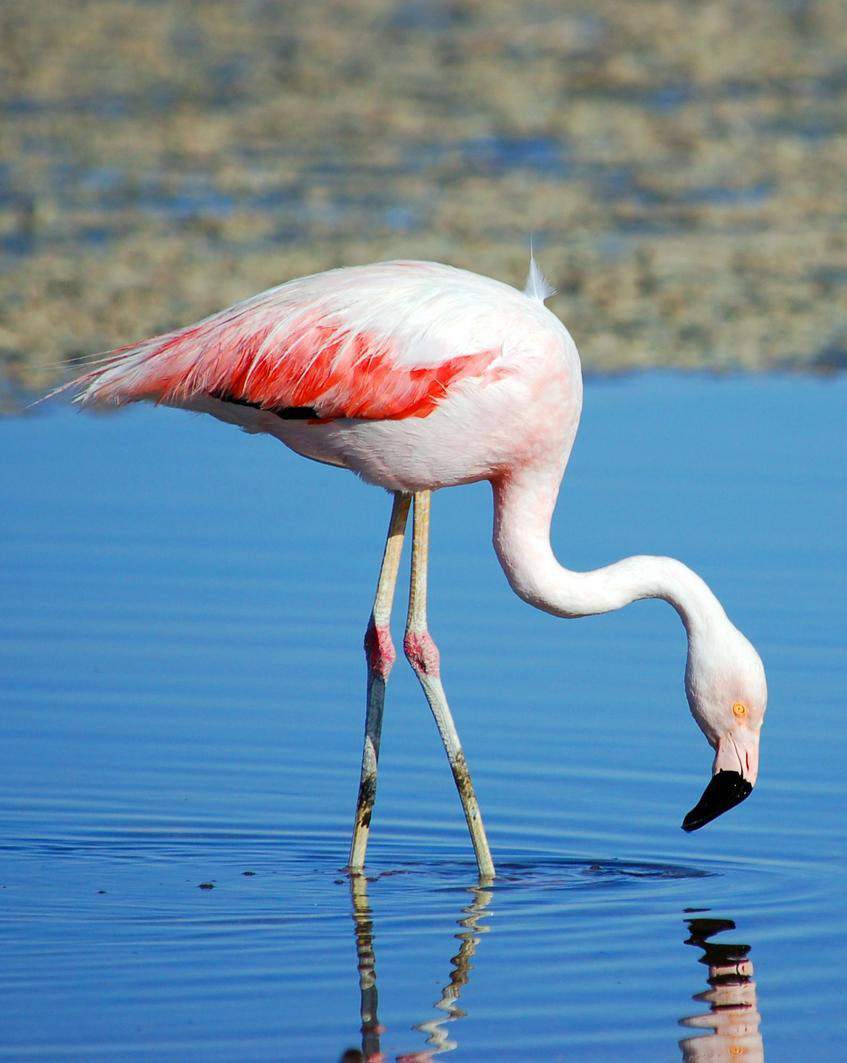
The Chilean Flamingo (Phoenicopterus chilensis) is the most widespread of the South American flamingos.
Although it shares parts of its range with the Andean and James's Flamingo, it is more closely related to the Caribbean and Greater Flamingo. Together, these three species form the genus Phoenicopterus.
It is distinguished from all other flamingos by its gray legs, with pinkish knees and feet. It is intermediate in size between the Andean Flamingo and the James's Flamingo.
General:
«Dwarf Flamingo»
Dwarf Flamingo,
(Phoeniconaias minor).
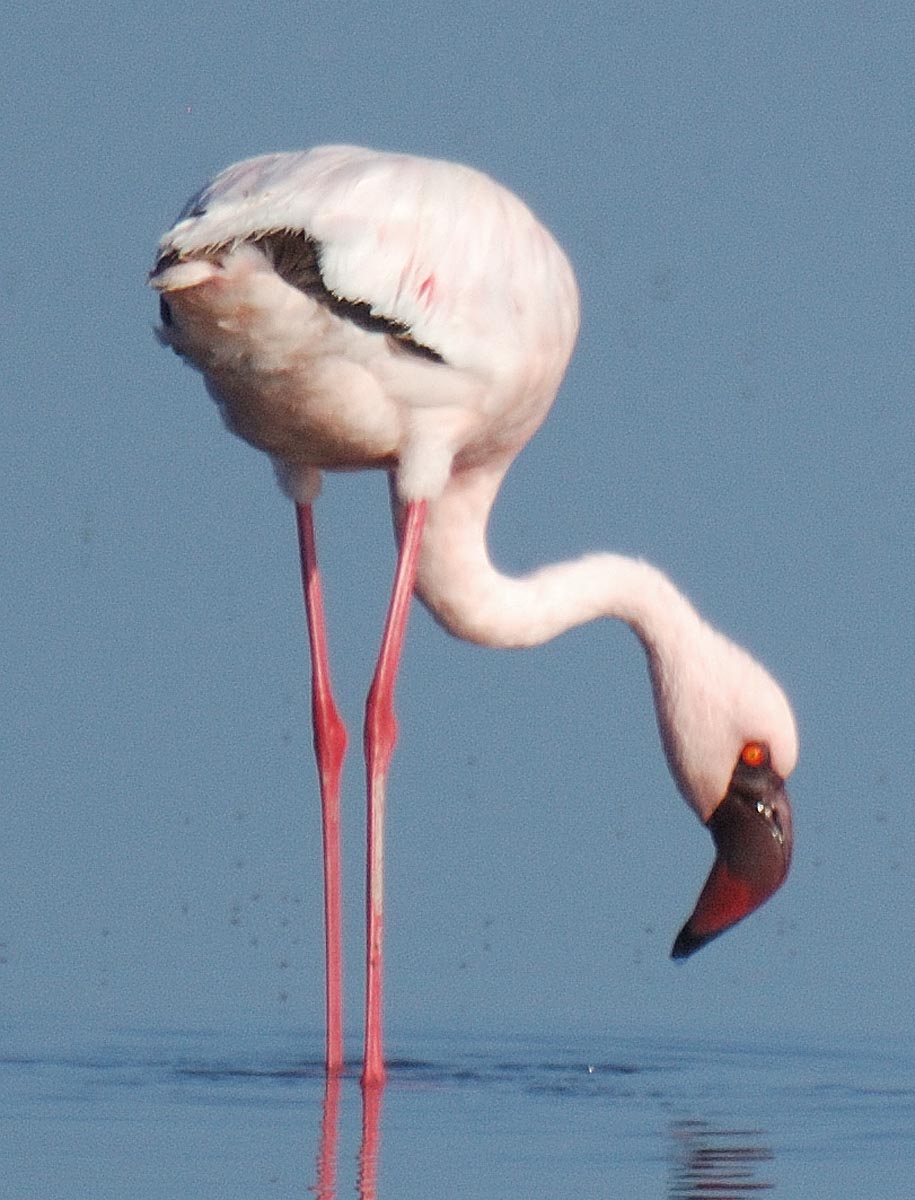
The Lesser Flamingo (Phoeniconaias minor) is the smallest and most numerous of all the flamingo species. It is estimated that its total population ranges from 2,220,000 to 3,240,000 individuals. To date, 4 regional subpopulations have been identified.
It is distinguished from all other flamingos by its small size, its beak is dark in color and its eyes are red. It is the only member of the genus Phoeniconaias, which translates to "Crimson Water Nymph."General:
"Andean Flamingo"
Andean Flamingo,
(Phoenicoparrus andinus).
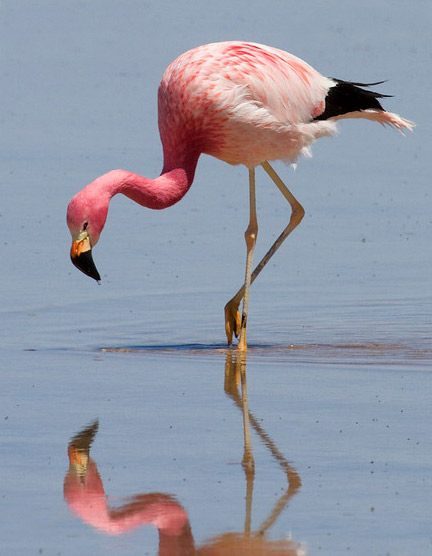
The Andean Flamingo (Phoenicoparrus andinus) is the largest flamingo in South America and is found in the high Andean plateaus of Peru, Chile, Bolivia and Argentina.
Distinguished from other flamingos by its yellow legs, purplish-pink plumage, and a large amount of black color visible when upright.
It is more closely related to the Jmaes flamingo and the two are the only ones belonging to the genus Phoenicoparrus.
General:
"James Flamingo"
James Flamingo,
(Phoenicoparrus jamesi).
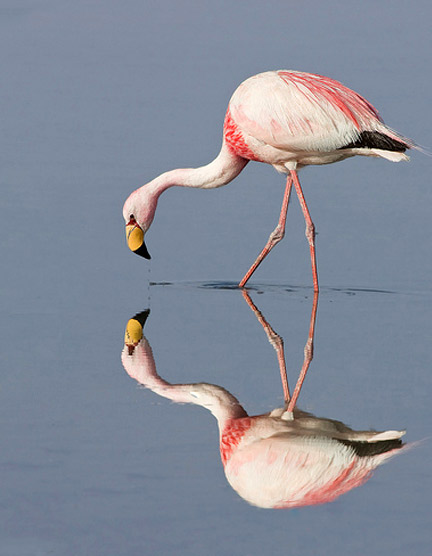
Tl James Flamingo (Phoenicoparrus jamesi) is a small flamingo from South America. It is found in the high Andean plateaus of Peru, Chile, Bolivia and Argentina.
It is the palest of the South American flamingos and is distinguished from all other flamingos by its orange legs, yellow bill, and red skin near the eyes. It is most closely related to the andean flamingo , and the two are the only members of the genus Phoenicoparrus.
James Flamingo was named for the Henry James of Berkeley , an English naturalist, who financed expeditions to Chile to collect samples of birds,
butterflies and moths. On one expedition he collected a sample of a new Flemish, which Philip Sclater later describes in the Proceedings of the Zoological Society (1886) and called it James's Flemish.


